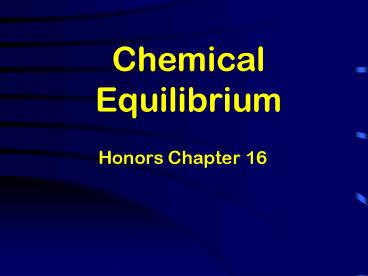Chemical Equilibrium - PowerPoint PPT Presentation
1 / 20
Title:
Chemical Equilibrium
Description:
Reactions can go Forward or in Reverse. A B AB ... The reaction will move in the forward dirction. If pressure is decrease, there is more volume. ... – PowerPoint PPT presentation
Number of Views:21
Avg rating:3.0/5.0
Title: Chemical Equilibrium
1
Chemical Equilibrium
- Honors Chapter 16
2
Equalized
- All reactions want stability. This is obtained
by chemicals moving back and forth until the
reaction is stable. - Equilibria plural for Equilibrium
3
What is Equilibrium Constant
- All reactions contain a limited number of atoms
in each direction. - Reactions can go Forward or in Reverse
- A B AB
- Remember Vapor Pressure is noted by the number
of molecules at equilibrium in the liquid or gas
state.
4
Graph to Equilibrium
A
Concentration
Equilibrium
B
Time
5
Rate of the Reactions
Rate of the Forward Reaction
Rate
Rate of the Reverse Reaction
Equilibrium
Time
6
What is equilibrium?
- At equilibrium the reaction is still proceeding
- However, it is proceeding at the same rate in
both directions (note the double arrow) - rate to the right the rate to the left
- Therefore, while individual molecules will react,
the overall concentration of any reagent will
remain constant. - Some example reactions...
- THE REACTION DOES NOT STOP, keeps moving in both
directions
7
The Law of Chemical Equilibrium
- Remember The reversible reaction achieves
equilibrium when the rate of the forward reaction
is equal to the rate of the reverse. - LAW OF MASS ACTION the relative concentrations
of reactants and products at equilibrium in terms
of quantity called equilibrium constant.
8
The Equilibrium Constant (K or Keq)
- Numerical (unitless) value used to evaluate the
status or state of a reaction - Determine which way it will progress
- Useful in all areas of chemistry and many other
sciences - Several different variations
9
- (homogenous reactions) Solution concentrations
are in Molarity - (homogenous) Gas concentrations are in pressures
(usually atm, but can be defined in other units) - (heterogenous) Solids have unitless
concentrations of 1 - When the calculated K is at the standard value,
the reaction is at equilibrium. - There is a unique K for each reaction and each
temperature - Unique at pressures too, since they may vary
concentrations!
10
Keq
- aA bB cC dD
- a, b, c, d represent coefficients
- ABCD represent compounds
Keq Cc Dd Aa Bb
11
What is the equilibrium expression for the
reaction (homogenous reaction)2CO O2 2CO2
- Keq CO22
- CO2O2
Why no numbers? Because we do not know the
Molarity of the compounds
12
What is the equilibrium expression for the
homogenous reaction2CO O2 2CO2
- Keq CO22
- CO2O2
What if we have the molarity Carbon Dioxide
0.0100 M Carbon Monoxide 0.0200 M Oxygen
0.0200 M
13
What is the equilibrium expression for the
Homogeneous reaction2CO O2 2CO2
- Keq 0.0100M2
- 0.0200M20.0200M
Keq 12.5
14
Heterogenous reaction
- C (s) H2O (g) CO (g) H2
(g) - Carbon is a solid and can not be measured in
molarity. In this case, Carbon has a unit of 1. - Keq COH2
- H2O
15
Manipulating Equilibrium Constants...
- Homogenous equilibrium look at all compounds
- Heterogenous equilibrium all solids have a unit
of 1 since they can not be measured in M. - Keq gtgt 1 the reaction is towards the products
- Keq ltlt 1 the reaction is towards the reactants
(barely moves)
16
Le Chateliers Principle
- If we disturb a reaction at equilibrium
- 1. change in Temperature
- 2. Change in Pressure
- 3. change in Concentration
- The reaction rates will shift to try to
re-establish equilibrium concentrations of all
reagents - the rate in one direction will exceed the other
17
The Reaction Quotient
- The reaction quotient (Q) is used to determine if
the reaction is at equilibrium. - If Q lt Keq then the equation falls toward the
products. This means that reactant will react
and produce more product, and less reactants are
left over compared to equilibrium. - If Q gt Keq then the equation falls toward the
reactants. This means that more reactants are
left over than products that could be made. - If Q Keq then the equation is at equilibrium.
18
Changes in Concentration
- All reactions will shift in reverse or forward to
achieve equilibrium. - Forward ? ? Backward
- If you add a concentration of a compound to the
reaction, the reaction will try to balance out. - Example NO2 ? N2O4
- If you add N2O4 to a stable reaction, the
reaction will shift in reverse, changing N2O4
into NO2 until equalized.
19
Change in Pressure
- Take the equation
- 2NO2 ? N2O4 There are 2 moles to 1 mole ratio
- If the equation is at equilibrium, and pressure
is applied decreasing the volume. Now the
reaction must move in the direction to decrease
the number of moles - The reaction will move in the forward
dirction. - If pressure is decrease, there is more volume.
The reaction will move in the direction to
increase the number of moles, it will now move in
reverse.
20
Change in Temperature
- Relates to Exothermic or endothermic reactions.
- If a reaction is exothermic in one direction,
then it is endothermic in the reverse. - If the reaction is exothermic (gives off heat)
and heat is added, the reaction will move toward
the reactants. - If the reaction is endothermic, and the reaction
is cooled the reaction will move toward the
products.































